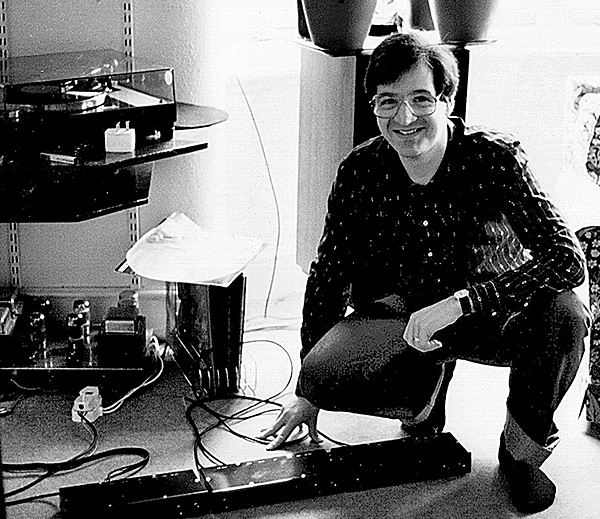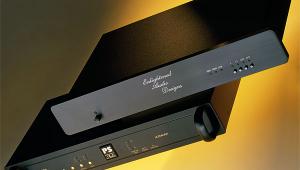British pre-conceptions (August 1985)

By 1985 standards, preamps selling for between £500 and £1000 are thought of as 'upper mid-fi' and not really expected to match the standards of the Krell PAM-3/Audio Research SP-10 variety. But they should bring you close enough to the state-of-the-art that you have to think long and hard about justifying an expenditure of double their prices – or even more. Aah, diminishing returns...
The Musical Fidelity MVT and Deltec CTA 80 are solid-state, op-amp based, British-made preamps of the no- or few-frills order. No filters or tone controls are present to upset the signal's path, but then it's doubtful that anybody (except the Japanese) would imagine they could get away with installing gadgets in components that could only appeal to purists. Who else would drop this kind of money on a preamplifier?

I auditioned both models in a set-up consisting of an Oracle/Zeta turntable/ arm combination, Beard valve amps, and Apogee Scintilla ribbon speakers. The only departure from my reference was the substitution of a Koetsu Black in place of the Garrott Decca, as the Deltec came to me in MC form. Though I tried the MVT with the Decca to test its MM inputs, the comparative remarks refer to the use of the Koetsu with both.
Musical Fidelity MVT
Musical Fidelity first entered our consciousness with 'The Preamp'. lt was an instant hit and as Musical Fidelity wanted to move upmarket (The Preamp sells for less than half the MVT's £800), it was logical the company would come up with a design less bound by cost restraints. Imagine, then, the shock upon seeing a preamp so physically arresting, coming from a company with a track record for aesthetic disasters. I genuinely believed that the MVT came from some purveyor of luxury goodies like Threshold or Krell before reading the logo.
A thick, charcoal grey metal fascia instead of the cheesy Perspex of The Preamp, all connectors gold-plated, outboard power supply connected by a meaty pro-league plug – had MF's founder Antony Michaelson finally seen the light? The clean fascia sports, from left to right, an on/off toggle switch and red LED, a smooth-acting volume control, a balance control with centre detent, a tape monitor switch choosing between source and two decks, and a source selector offering disc, CD, tuner and tapes 1 or 2.
The back of the amp, festooned with gold-plated sockets, contains four pairs of phono inputs, two pairs each for MM or MC. One set is for the actual input, while the other can be used to insert plugs with resistors (or capacitors) for loading freaks like Garrott Decca users. Between the four pairs can be found a push button to choose either MM or MC.

One other notable inclusion is a choice between inverting or non-inverting outputs. Naturally, this meant love at first sight though I'd have preferred a front-panel switch as I spent a few thousand words on the matter of absolute signal polarity in the June issue. Meanwhile, studio types will be pleased to know that XLR outputs are available.
The output amplifier provides 2W of pure Class A juice, which will actually drive a high-sensitivity loudspeaker. Output impedance is said to be less than 0.1ohm and it seems like it'll drive just about anything. As for the outboard power supply, this is connected to the unit by a lead captive at the preamp end but terminating in a chunky three-pin affair. The power supply has its own on-off switch in addition to the one on the preamp's fascia.
Moving on to the MC stage, this is of the high-current sort, incorporating an ultra low-noise DC servo feedback loop, using 18dB of feedback. The MM stage provides 100% common mode rejection, and is the result of work by its designer Martin V Thomas (note the initials) on the retrieval of electrical signals from living nervous systems, which behave – so I've been informed – a lot like MM cartridges.

Computer Grade
Brand-name lovers take note: the pots used are from ALPS and the custom-made selector is a WASP. Polycarbonate capacitors are used in abundance, and the MC input cap is 'of computer grade' (not Sinclair I hope). Every stage in both channels is regulated separately, the power transformer is a 160 watter, and the net effect is one of overkill. In other words, what we have here are all the ingredients needed for an assault on the high-end market.
I like a transistor preamp. (Actually, I like about a dozen of them, even though it's not in keeping with my image.) The MVT is so unlike the majority of glassy, brittle, or two-dimensional UK-made solid-state preamps I've tried that I could easily mistake it for a Klyne or one of the latest-generation Krells. lt has authority. lt operates in three dimensions. it's sweet and natural sounding. And it's very, very fast. I would even go so far as to say that it almost sounds tube-like.























































